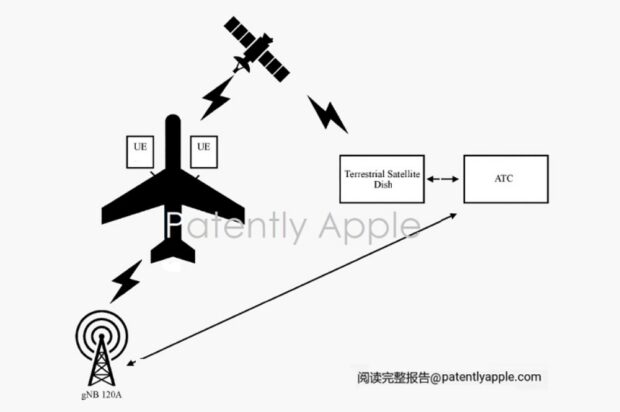With Apple introducing Emergency SOS via Satellite for iPhone 15, Apple patents regarding communications, including non-terrestrial network networks NTN, all of a sudden takes on new interest, especially for wireless system engineers and other communication specialists.
On March 2nd. the US Patent & Trademark Office published a patent application from Apple that relates to collecting User Equipment (iDevice, MacBook etc.) positioning in Non-Terrestrial Networks (NTN). In one scenario, Apple is working on a system that will allow a user’s iPhone or MacBook’s communication system contact Air Traffic Control should a plane’s system go radio silent for whatever reason. This invention also extends to major communication breakdowns on trains and buildings. In the 911 disaster, radio silence kept firefighters from communicating with command posts for instructions. Apple’s working in this area is another project that may very well work itself to future Apple devices.
Collecting UE Positioning Information In A Non-Terrestrial Network
According to Wikipedia, in the Universal Mobile Telecommunications System (UMTS) and 3GPP Long Term Evolution (LTE), user equipment (UE) is any device used directly by an end-user to communicate. It can be a hand-held telephone, a laptop computer equipped with a mobile broadband adapter, or any other device.
In Apple’s patent background they note that a user equipment (UE) may connect to a non-terrestrial network (NTN). An NTN may generally refer to any network that may involve a non-terrestrial flying object, e.g., satellite communication networks, high altitude platform systems, air-to-ground (ATG) networks, etc. It has been identified that there is a need for mechanisms related to collecting UE positioning information in the NTN.
According to some aspects of this invention, the exemplary embodiments introduce mechanisms for collecting positioning information from a UE located on an airplane.
Airplanes are equipped with a global positioning system (GPS) and/or global navigation satellite system (GNSS) for navigation. The airplane may relay its positioning information to Air Traffic Control (ATC) using a satellite link and/or a base station configured to support ATG communication. It has been identified that there is a need for alternate approaches in case an issue occurs that prevents the airplane from relaying its positioning information to ATC.
For example, an event may occur that intentionally or unintentionally causes the airplane to go radio silent and as a result, there may be no way for ATC to directly locate the airplane via the airplane’s transceiver. The exemplary embodiments introduce mechanisms for collecting UE positioning information from one or more UEs located on the airplane.
While this information may be used to assist in locating an airplane within the context of the example scenario described above, e.g., radio silent airplane, the exemplary embodiments are not limited to any particular type of scenario or conditions during which UE positioning information is collected. Other scenarios could include a train, bus, building, field etc.
The exemplary embodiments relate to a Non-Terrestrial Network (NTN) that generally refers to any network that may involve non-terrestrial flying objects, e.g., satellite communication networks, high altitude platform systems, air-to-ground (ATG) networks, unmanned aerial vehicle (UAV) networks, etc.
In other examples, UEs may communicate with one another using a sidelink. The term “sidelink” generally refers to a communication link between a UE and a further UE. The sidelink provides direct device-to-device (D2D) communication where information and/or data exchanged between the UE and the further UE via the sidelink does not go through a cell. In some configurations, a single sidelink provides bidirectional communication between the UE and the further UE. In other configurations, a single sidelink provides unidirectional communication between the UE and the further UE. The exemplary embodiments may apply to either a bidirectional or unidirectional sidelink.
Sidelink communications are supported by 5G NR and other 3GPP standards.
In some configurations, the network may provide information to the UE that indicates how a sidelink is to be established, maintained and/or utilized. Thus, while the information and/or data exchanged over the sidelink does not go through a cell, the UE and the network may exchange information associated with the sidelink. In other configurations, a sidelink is not under the control of the network. In either configuration, the UE and the further UE may still perform synchronization procedures, discovery procedures and exchange control information corresponding to the sidelink.
Wireless engineers and technical geeks could discover more details in Apple’s patent application number US 20230065533 A1
Apple Inventors
- Yang Tang: 3GPP RAN4 lead and Sr. Manager
- Xiang (Steven) Chen: Wireless Systems & Standards. Former 3GPP RAN4 Chair
- Huaning Niu: Wireless system engineer
- Manasa Raghavan: Wireless Systems Engineer
- Zhibin Wu: Engineer (Spent 15 years with Qualcomm)
- Jie Cui: Emerging Technologist
- Hong He: Standards Engineer (was a 3GPP System Engineer at Intel)
- Zhang Dawei: Researcher
Source: Patently Apple

